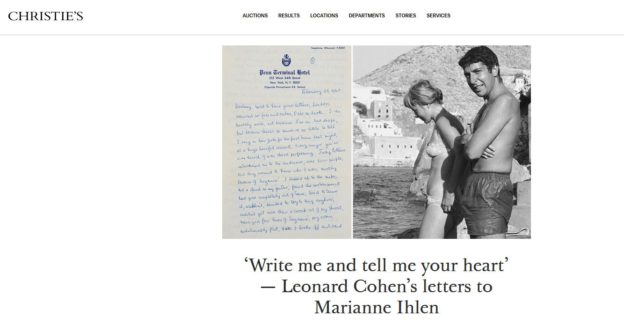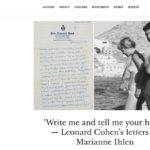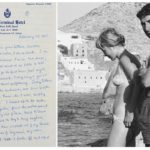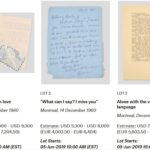‘Write me and tell me your heart’ — Leonard Cohen’s letters to Marianne Ihlen
This June Christie’s brings to auction more than 50 letters from Leonard Cohen to his muse and lover, together with seven of Marianne Ihlen’s own letters. Together they offer fascinating glimpses of the young poet’s yearnings and artistic struggles
Two parallel stories unfold across this remarkable correspondence between Leonard Cohen and Marianne Ihlen, his muse and lover. The first is that of the romantic relationship that inspired songs such as So Long, Marianne and Hey, That’s No Way to Say Goodbye, with the letters revealing a deep tenderness that never fades, even long after they’ve parted. They underscore Marianne’s role during pivotal years as a bedrock for Leonard, in both his life and work.
The second story is that of Leonard Cohen the artist. The letters begin in 1960 when he is a 26-year-old struggling writer with a single book of poetry under his belt, and go on to cover the writing, revision, and publication of nearly everything that follows, including his transition in the mid-1960s from poet and novelist to singer-songwriter. They span to 1979, save for one later postcard, which was written in the 2000s.
Cohen first arrived in the Greek island of Hydra in April 1960 and quickly fell for the bohemian lifestyle if offered. He purchased a house on the island that September with the proceeds of a small inheritance.
Marianne was married to Norwegian novelist Axel Jensen at this time, and they had a baby together. But the marriage was troubled and Marianne and Leonard were quickly drawn to each other. During their years together she would provide him with a nourishing, stable existence.
Their relationship, however, was often long-distance and occasionally turbulent, and it eventually drew to a close as Cohen’s career as a musician began. Even so, notes and letters were exchanged for many years after they parted, highlighting what Cohen refers to in one letter as their ‘enduring love’. And as he sings in Hey, That’s No Way to Say Goodbye, ‘You know my love goes with you as your love stays with me / It’s just the way it changes, like the shoreline and the sea.’
These important letters shine a light on Leonard Cohen’s love, his life and work — through his own poetic words. They contain numerous lines and passages that sound like early drafts of songs, with each one giving new context, new understanding, to his oeuvre.
Find out more about the story of Leonard Cohen and his greatest muse
Postmarked from all over the world, they take us from Hydra and Cuba to the Chelsea Hotel and Nashville, from Scientology to Zen Buddhism, from young poet to world-famous artist.
Cohen’s first separation from Marianne
This early letter was written from the beaches of Tel Aviv, marking Cohen’s first separation from Marianne after meeting her earlier in the year. It is more formal and self-conscious than letters that follow, and he describes feeling jarred by city life after so much time on their idyllic Greek island.
The letter closes with a line that reads like song lyrics: ‘It’s hard to write you. The surf is too loud. The beach is too crowded, and you’re too much in my heart to put anything down.’
The difficulties of a long-distance romance
Writing from 3702 Mountain Street, in Montreal, this letter from early 1961 reveals the strains of being apart. During this period, Cohen was dividing his time between Greece and Canada, essentially returning to Montreal periodically in order to earn money to fund his life in Hydra.
A recurring theme throughout the letters is the conflict he feels between love and independence; despite his love for Marianne he is compelled to be on his own, but once on his own, he longs for her. ‘Forgive my long silence. I have not even spoken to myself,’ he writes, before closing ‘Write me and tell me your heart.’
‘I want you to come to New York very soon’
Optimistic about career opportunities and grateful for her support of his novel, The Favourite Game, which would be published later that year, Cohen writes to ask Marianne to join him in New York. ‘I want you to come to New York very soon and I’m working to arrange it. There’s a fair chance that a U.S. magazine will use a section of my book before publication and that will mean some money.’
Sign up today Christie’s Online Magazine delivers best features, videos, and auction news to your inbox every week, look for: https://www.christies.com/features/Leonard-Cohen-letters-to-Marianne-Ihlen-9838-1.aspx
He closes: ‘I could never have rewritten my book without you, and I don’t think I’ll write another one without you. So if I don’t make a fortune within the next little while, let’s get back to Hydra and be poor together.’
Cohen’s reinvention as a singer-songwriter
‘I sang in New York for the first time last night,’ Cohen reveals in this letter from February 1967. After years of struggling as a poet and novelist, in the mid-1960s he decided to pursue a music career. He was championed by Judy Collins, who recorded Suzanne with great success, and his first album, Songs of Leonard Cohen, was released in December 1967. This letter is on Penn Hotel letterhead, and it is during a stay there that he would write Hey, That’s No Way to Say Goodbye.
Bleeker Street and Nico
‘I put steel strings on my guitar, that’s like changing from underwear to armour, that’s New York City.’ In the course of this fabulous letter written from Bleeker Street, Cohen captures the texture of city life, the current music scene, and his ‘enduring’ love for Marianne. He would sign with Columbia Records only a few weeks later, on 26 April, earning an advance of $2,000.
‘Ring the bells that still can ring’
In his song Anthem, Cohen famously writes ‘Ring the bells that still can ring / Forget your perfect offering / There is a crack, a crack in everything / That’s how the light gets in.’ This bell originally decorated a staircase in Marianne’s home in Hydra before accompanying her when she went to live with Cohen. It sat in various places, including on his desk for many years, and most likely provided inspiration for one of his great lyrics.
Estimate: USD 6,000 – USD 9,000
Autograph letter signed (“Cohen”) to Marianne Ihlen („My dear Marianne“), Tel Aviv, 13 September 1960.
Two pages, 270 x 202mm, pencil on lined paper; with transmittal envelope (torn).
“It’s hard to write you. The surf is too loud. The beach is too crowded, and you’re too much in my heart to put anything down.”
An important early letter written from the beaches of Tel Aviv, marking his first separation from Marianne after meeting her earlier in the year. Fleeing rainy London, Cohen first arrived in Hydra in April 1960. Enamored with simple island life and the bohemian community, he would purchase a house there that September with the proceeds of a small inheritance. Marianne was married to Norwegian novelist Axel Jensen at this time and they had a baby together. But the marriage was troubled and Marianne and Leonard soon came together, though he would later recall that initially they “didn’t think there would be a love story. We thought we would live together” (qtd in Nadel, Various Positions, p. 83).
This letter is more formal and self-conscious than those that follow. Feeling jarred by the city and longing for Hydra, Cohen opens: “My dear Marianne, I just want to write you.” He quotes a Chinese poet whose name he had forgotten: “’What is the use of speaking? / There is no end / to the things of the heart.” He writes of feeling lost in Israel and contemplates spending more time learning Hebrew. On his work he reports: “The novel is finished, but I haven’t gathered strength for the 3rd draft. I miss the whiteness of Hydra and the bare rooms of my house.” As he will do often in the letters that follow, he mentions that he has sent money. He closes: “Well, I’ve got no more gold hair and I’m back to a familiar loneliness which is not too unpleasant, except when I compare it with certain intimacies I’ve known.”
Please note this lot is the property of a private individual.




